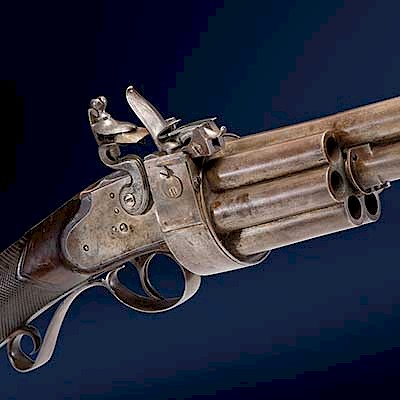Unmarked Two-Barreled Revolving Cartridge Carbine
About Seller
6270 Este Ave.
Cincinnati , OH 45232
United States
With offices in Cincinnati, Cleveland and Denver, Cowan’s holds over 40 auctions each year, with annual sales exceeding $16M. We reach buyers around the globe, and take pride in our reputation for integrity, customer service and great results. A full-service house, Cowan’s Auctions specializes in Am...Read more
Two ways to bid:
- Leave a max absentee bid and the platform will bid on your behalf up to your maximum bid during the live auction.
- Bid live during the auction and your bids will be submitted real-time to the auctioneer.
Bid Increments
| Price | Bid Increment |
|---|---|
| $0 | $25 |
| $500 | $50 |
| $1,000 | $100 |
| $2,000 | $250 |
| $5,000 | $500 |
| $10,000 | $1,000 |
| $20,000 | $2,500 |
| $50,000 | $5,000 |
| $100,000 | $10,000 |
About Auction
Nov 28, 2018
This single-owner sale features the unparalleled firearms collection of Mark Aziz, featuring a lifetime's worth of high quality, historically important military and sporting firearms scholarship. The one-day sale will include dozens of scarce and unique examples of revolving firearms development, Cowan's Auctions dawnie@cowans.com
- Lot Description
.50RF and .36 caliber, 21" and 20" barrels, no S/N. A unique and unmarked LeMat inspired revolving carbine design with a 21", 50RF central barrel rifled with 7 grooves that serves as the arbor around which rotates a 2" long, 9-shot fluted cylinder that fires its nominally .38 caliber cartridges through an apparently smoothbore lower barrel that at first glance resembles a magazine tube. A large, conventional style loading gate provides access to the central chamber, while a smaller loading gate is concealed in the fluted rear portion of the frame's flash guard, providing access to the cylinder. A two-trigger system operates the gun, with the rear trigger rotating the cylinder and firing the cartridges in it and the forward trigger apparently firing the central barrel. Equipped with an unmarked Pattern 1853 Enfield rear sight and a fixed blade front sight. A clamping band is present forward of the cylinder, possibly made from a modified musket barrel band, which includes a fixture on the upper right side, aligned with the loading gate, for the mounting of an ejector rod, now missing. The fixutre includes a tension spring, similar to the Lefaucheux design, to retain the rod. Buttstock of walnut with a musket type butt and a long, slender wrist reminiscent of Gwyn & Cambell carbines with a central bolt. Carbine style partial forend retained by a single screw tensioned barrel band of Enfield pattern with a sling swivel attached. A second, smaller, screw clamping band provides additional security to the two barrels. An interesting revolving cartridge carbine that may have been the work of some unknown frontier gunsmith or possibly a working model for design that was never pursued or patented. Likely chambered for .50-70 and some variant of an 1870s era .38 cartridge with a nominally .36 heeled bullet and a .38" case diameter.Good. Retains no finish with a thickly oxidized brown patina showing scattered light pitting over most of the metal. No visible markings. Somewhat functional, with the rear trigger usually revolving the cylinder and releasing what is likely a concealed, internal striker. The exposed hammer will not hold on any cocked position and the front trigger appears frozen and does not currently appear to do anything. Central bore good, evenly oxidized with visible rifling, lower bore moderately oxidized and apparently smooth. The frame collar in front of the cylinder is broken on the bottom and missing a screw, ejector rod is missing, upper frame tang screw is missing. Stock loose on frame with a full-length grain crack on the obverse running from the butt to the lower tang, forend with some splintering along the lower edges. Both pieces with scattered bumps and dings.
Condition
- Shipping Info
-
Buyers are required to pay for all packing, shipping and insurance charges. Overseas duty charges are the responsibility of the successful Bidder. Be aware that for larger and/or valuable items, shipping charges can be substantial. - If there is no shipping amount on listed your invoice, you will need to make arrangements to pick up or ship your purchase through an alternative shipping company. Our shipping department can be contacted at 513.871.1670 (ext. 219) or email shipping@cowans.com. - Shipping charges include insurance for your order while in transit. If you have private insurance we will adjust your charge to include only packing and shipping. - Please allow 14 – 21 days after payment to package and ship your purchase as carefully as possible.
-
- Buyer's Premium



 EUR
EUR CAD
CAD AUD
AUD GBP
GBP MXN
MXN HKD
HKD CNY
CNY MYR
MYR SEK
SEK SGD
SGD CHF
CHF THB
THB














